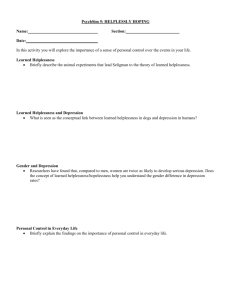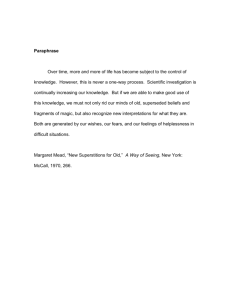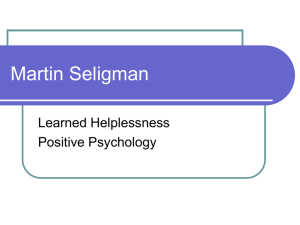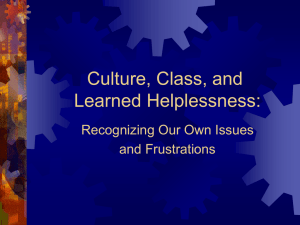“Today's Children, Tomorrow's Leaders”: Are we Neglecting the Agents... Abstract Assegedetch HaileMariam
advertisement
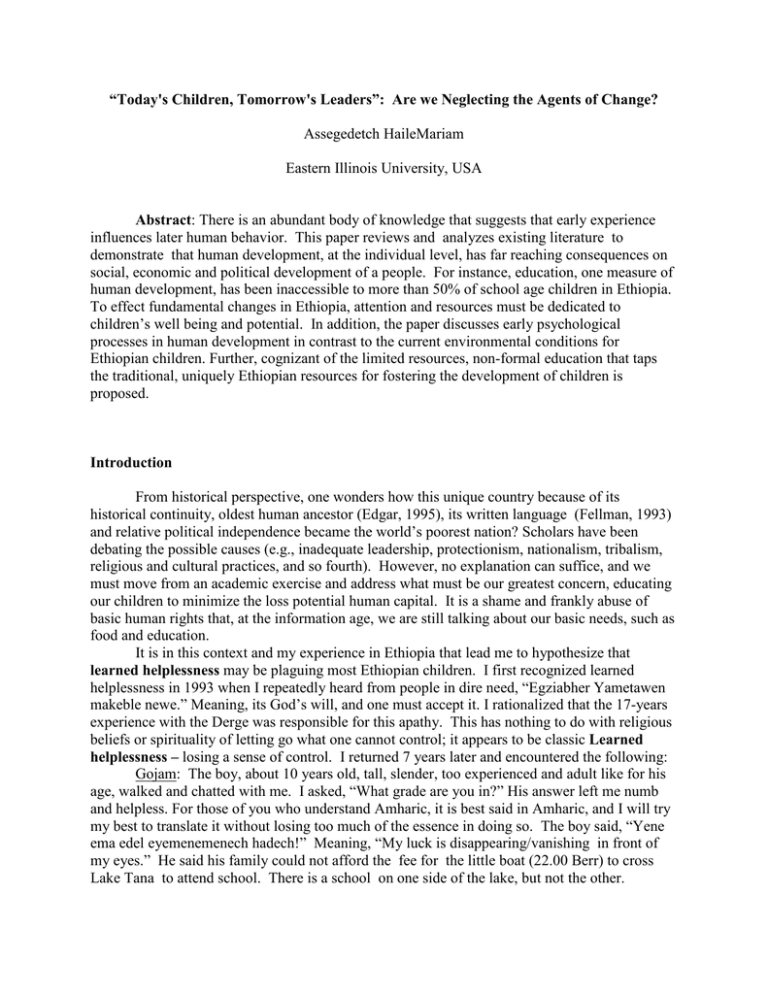
“Today's Children, Tomorrow's Leaders”: Are we Neglecting the Agents of Change? Assegedetch HaileMariam Eastern Illinois University, USA Abstract: There is an abundant body of knowledge that suggests that early experience influences later human behavior. This paper reviews and analyzes existing literature to demonstrate that human development, at the individual level, has far reaching consequences on social, economic and political development of a people. For instance, education, one measure of human development, has been inaccessible to more than 50% of school age children in Ethiopia. To effect fundamental changes in Ethiopia, attention and resources must be dedicated to children’s well being and potential. In addition, the paper discusses early psychological processes in human development in contrast to the current environmental conditions for Ethiopian children. Further, cognizant of the limited resources, non-formal education that taps the traditional, uniquely Ethiopian resources for fostering the development of children is proposed. Introduction From historical perspective, one wonders how this unique country because of its historical continuity, oldest human ancestor (Edgar, 1995), its written language (Fellman, 1993) and relative political independence became the world’s poorest nation? Scholars have been debating the possible causes (e.g., inadequate leadership, protectionism, nationalism, tribalism, religious and cultural practices, and so fourth). However, no explanation can suffice, and we must move from an academic exercise and address what must be our greatest concern, educating our children to minimize the loss potential human capital. It is a shame and frankly abuse of basic human rights that, at the information age, we are still talking about our basic needs, such as food and education. It is in this context and my experience in Ethiopia that lead me to hypothesize that learned helplessness may be plaguing most Ethiopian children. I first recognized learned helplessness in 1993 when I repeatedly heard from people in dire need, “Egziabher Yametawen makeble newe.” Meaning, its God’s will, and one must accept it. I rationalized that the 17-years experience with the Derge was responsible for this apathy. This has nothing to do with religious beliefs or spirituality of letting go what one cannot control; it appears to be classic Learned helplessness – losing a sense of control. I returned 7 years later and encountered the following: Gojam: The boy, about 10 years old, tall, slender, too experienced and adult like for his age, walked and chatted with me. I asked, “What grade are you in?” His answer left me numb and helpless. For those of you who understand Amharic, it is best said in Amharic, and I will try my best to translate it without losing too much of the essence in doing so. The boy said, “Yene ema edel eyemenemenech hadech!” Meaning, “My luck is disappearing/vanishing in front of my eyes.” He said his family could not afford the fee for the little boat (22.00 Berr) to cross Lake Tana to attend school. There is a school on one side of the lake, but not the other. Tomorrows’ Leaders 2 Learned Helplessness Learned helplessness is a psychological state induced by previous experiences with situations perceived as uncontrollable. In other words people learn that the probability of changing the negative situation is beyond their control. As a consequence, they lose the desire to act and develop a disturbance in motivation, emotions, and cognitive processing resulting in symptoms including: (a) passivity, (b) depression, and (c) decreased expectations regarding future outcomes (Schunk, 1991; Olson & Schober, 1993). “In brief the motivational deficit consists of retarded initiation of voluntary responses and is seen as a consequence of the expectation that outcomes are uncontrollable. If the organism expects that its responses will not affect some outcome, then the likelihood of emitting such responses decreases. Second, the learned helplessness hypothesis argues that learning that an outcome is uncontrollable, results in a cognitive deficit since such learning makes it difficult to later learn that responses produce that outcome. Finally the learned helplessness hypothesis claims that depressed affect (resignment) is a consequence of learning that outcomes are uncontrollable.” (Abramson, Seligman, & Teasdale, 1978, p. 50) The process of developing the state of “learned helplessness” was described by Abramson et al. (1978, p. 50) as follows: The Seligman model of learned helplessness Objective uncontrollability Perception of present and past uncontrollability Expectation for future uncontrollability Symptoms of helplessness Support for the idea that a feeling of helplessness can be learned appeared first in the studies of animals. In the classic study, Bruce Overmier and Martin Seligman (1967) administered electric shocks to the forepaws of a group of dogs. These dogs received shocks no matter what they did (inescapable). Then these dogs and a comparison group of dogs that had no experience with unavoidable shock were placed in a large box where they could avoid being shocked (escape). Dogs who had no history of experiencing unavoidable shocks quickly learned to avoid the shock. But the dogs that had previously been subjected to an experience with inescapable shocks did not learn to avoid the shock; they lay down and whined (Seligman & Maier, 1967). This is the effect known as learned helplessness. Research on learned helplessness with human adults indicates that when people are put in situations in which they cannot control events, they too eventually become passive and lose even Tomorrows’ Leaders 3 the desire to act (Fincham & Cain, 1986; Seligman, 1975). Learned helplessness has been observed in infants as well. Infants given no control over the movement of a toy showed more subsequent difficulty in learning to operate the toy than others who were given control over toy movement (Watson, 1977). In this study, Watson (1977) contrasted the behavior of two groups of infants who were provided with mobiles for their cribs at home. One group could set the mobile in motion by pushing down on their pillows; the other group saw the mobile move equally often, but their own actions did not affect its movement. Later both groups were given an opportunity to make a similar mobile move in the laboratory. The infants who had learned to control the mobile at home soon learned to make the laboratory mobile move. The infants who could not control the mobile at home did not learn to control the laboratory mobile. In accord with the idea of learned helplessness, the experience of lack of control over an aspect of the environment in one situation seems to impair later learning in a similar situation. Nolen-Hoeksema, Girgus, and Seligman (1992) in a 5-year longitudinal study investigated the interrelationships among children’s experience of depressive symptoms, negative life events, explanatory style, and helplessness behaviors in social and achievement situations. The results revealed that early in childhood, negative events predicted depressive symptoms while later in childhood a pessimistic explanatory styles emerged as a significant predictor of depressive symptoms. On the basis of similar observations with infants and young children, the psychiatrist Robert White (1959) concluded that human beings have a basic drive to be in control of their environments. He called this drive the competence motive (A basic drive human beings have to control their environment.). Further, investigators have proposed that learned helplessness and/or its physiological concomitants may be an important determinant of a number of human conditions, including the coronary-prone personality, ulcers, and immunity to disease (Laudenslager, Ryan, Drugan, Hyson, & Maier, 1983; Seilgman, 1975). Fertile Ground for Learned Helplessness Ethiopia ranks among the lowest three countries in the world in terms of social development – education, health care and food security (UNDP, 1999). Although each of these variables have shown some relationship to the development of learned helplessness, the focus of this paper is on the relationship among the luck of primary education and learned helplessness, assuming education may buffer children from learned helplessness. Ten years ago, Ethiopia joined 155 countries of the world at Jomtein, Thailand and committed herself to universal access to primary education by the year 2000. However, by the year 2000, less than 50% of children were enrolled in primary schools (as low as 38% has been reported by UNICEF (Ministry of Education, 1999 In 1999/2000, the number of children who were enrolled and not enrolled in schools were about 6.5 million and 6.2 million, respectively. According to UNICEF (2000), Ethiopia has over 11 million children under the age of 5 and about 20 million children between the age of 6 and 18. Thus, the rate of increase in enrollment has not kept pace with the growth in the school-age population. Given the present high fertility rate (7.7 children per woman), the age structure of the population will be slow to change and the number of children eligible to attend primary school will continue to grow at a rapid rate: The current population of 64,117,452 (Hall, 2001) is expected to reach 112,000,000 by the year 2025 (Cutler, 1990). Tomorrows’ Leaders 4 In short, the report prepared for the United Nations Special Session on Children concluded, “One of the major challenges that requires urgent attention in the context of the effort to fulfill the rights of children to education in Ethiopia is to improve access to primary education in all regions. The task of reducing and eventually eliminating the gender gap in enrollment and completion rates at different stages of primary education remains a principal challenge.” (UNISCO, 2001) p. 13. Although compulsory free education, 7–13, exists on paper in Ethiopia (Hall, 2001), most children do not attend school, because families cannot afford school material (average per capita income is only $110.00 a year, World Almanac, 2001), school facilities are not available to most children, and cultural attitude is a big factor. Ethiopia spends 4% of its Gross National Product on education, however the objective is to achieve universal primary education by the year 2015, according to the National Human Development Report (UNDP,1998). Obviously, this ideal objective and the means for achieving it are incompatible. Statement of the Problem In Ethiopia, children who have no access to education more often are poverty stricken. They watch their families struggle to meet basic human needs, and they fail to see that the future would be any better for themselves. They judge their future based on their current and past experiences. The author suggests that this condition fits Seligman’s learned helplessness model; and primary education may offer these children a sense of hope and control about their future. It is further suggested that the literate and informed child will as an adult encourage his or her children to be educated, and also demand accountability from the leaders of the day. Short-term Solutions Until universal access to primary education is achieved and cognizant of the limited resources, non-formal education that taps the uniquely Ethiopian, indigenous resources for fostering the development of children is proposed, below. Non-formal education is a form of learning and teaching rooted in the community, strengthening the knowledge and skills needed to develop ones’ community and benefit from it (Prakash & Esteva, 1998; McGovern, 2000; and La Belle, 2000). In sum, non-formal education empowers a community to educate children. These researchers’ work, in several countries, suggests that 1. Non-formal education can be used to teach reading and writing, elementary mathematics, citizenship education, consciousness raising, basic hygiene, health and nutrition, child development and so on. 2. National Youth Service similar to the literacy campaign of the 1980s may be used to accomplish non-formal education: At the completion of high school, students may be required to give 1 year community based service similar to Israel or Korea. Community based National Youth Service will also minimize the language and cultural issues and dislocation. 3. Utilizing churches, mosques, government offices, hospitals and clinics address space issue (One of these is accessible even to the most remote community in Ethiopia.). 4. Using Educational Mass Media (Radio, pamphlet, poster, TV, etc.) is an effective way of disseminating information. Tomorrows’ Leaders 5 5. Appropriating more resources (including gradually introducing a small, but sustainable education tax) to cover expenses involved in non-formal education, e.g., school supplies, is a wise investment in the development of human capital. Conclusion and Discussion In conclusion, “learned helplessness” is the end-state of a process where individuals learn that the negative events occurring to them are not controllable; resulting in (1) low motivation to take further action to change the situation, (2) frustration that turns into depression and resignment and (3) lower general learning ability in similar coping situations (Seligman, 1975). It is argued that Ethiopian children without access to primary education may be experiencing learned helplessness; and that education may be one of the variables that may shelter children from developing a sense of learned helplessness. Until universal access to primary education is achieved, we owe it to our children to engage them in non-formal education to give them hope, decrease pessimism, and increase knowledge and skills because they are tomorrow’s leaders of their future families. It is well recognized that parents’ education is an important determinant of attendance and completion of school for both boys and girls. “This suggests that increasing educational opportunities of boys and girls of this generation will have a positive effect on schooling in the next generation.” (UNESCO, 2001). Further, according to the U.S. Department of Education (2001), the education of children is closely intertwined with their own personal development as well as the economic and social progress of a nation. Thus, for successful economic, social, and political development of Ethiopia; it is imperative that education be given a priority. Author’s Note: Please note that this paper is a work in progress, and the reader should view it as such. Tomorrows’ Leaders 6 References Abramson, L. Y., Seligman, M. E. & Teasdale, J. D. (1978). Learned helplessness in humans: Critiques and reformulation. Journal of Abnormal Psychology, 87, 49-74. Cutler, B. (1990). Our African future. American Demographics, 12, 2, 9 Edgar, B. (1995). Digging up the family bones. BioScience, 45, 10, 659-663 Fellman, (1993). The birth of an African literary language: The case of Amharic. Research in African Literatures, 1993, 24, 3, 123-126. Fincham, F. D. & Cain, K. M. (1986). Learned helplessness in humans: A developmental analysis. Developmental Review, 6, 4, 301-333. Hall, J. (2001). Ethiopia: What can be done? World and I, 16, 6, 56. La Belle, T. J. (2000). The nature of non-formal education in Latin America. Comparative Education, 36, 1, 21-37. Laudenslager, M. L., Ryan, S. M., Drugan, R. C., Hyson, R. L., & Maier, S. F. (1983). Coping and immuno-suppression: Inescapable but not escapable shock suppresor lymposite proliferation. Science, 221 568-570. McGovern, S. M. (2000). Reclaiming education: Knowledge practices in indigenous communities: Essay Review. Comparative Education Review, 44, 4, 523-529. Ministry of Education (1999). Education Statistics Annual Report. Addis Ababa. Nolen-Hoeksema, S., Girgus, J. S., and Seligman, M. E. (1992). Predictors and consequences of childhood depressive symptoms: A 5-year longitudinal study. Journal of Abnormal Psychology, 10, 3, 405-422. Olson, G. I. & Schober, B. I. (1993). The satisfied poor. Social Indicators, 28, 2, 173-193. Overmeir, J. B., & Seligman, M. E. P. (1967). Effects of inescapable shock upon subsequent escape and avoidance learning. Journal of Comparative and Physiological Psychology, 63, 23-33. Prakash, M. S. & Esteva, G. (1998). Escaping education: Living as learning within grassroots cultures. Counterpoints: Studies in the postmodern theory of education. New York: Peter Lang Publishing. Schunk, D. (1991). Learning theories - an educational perspective. New York: Merrill Seligman, M. E. P. (1975). Helplessness: On depression, development, and death. New York: W. H. Freeman. Seligman, M. E. P. & Maier, S. F. (1967). Failure to escape traumatic shock. Journal of Experimental Psychology, 74, 1-9. UNDP (1998). Human Development Report. New York. UNESCO (2001). Education for All. New York. UNICEF (2000). The state of Nations. New York. U.S. Department of Education (1999). National household education survey. National Center for Education Statistics, Washington D.C. Watson, J. (1977). Depression and the perception of control in early childhood. In J. G. Schulterbrandt & A. Raskin (Eds.), Depression in childhood: Diagnosis, treatment and conceptual models. New York: Raven Press. Tomorrows’ Leaders 7 White, R. (1959). Motivation reconsidered: The concept of competence. Psychological Review, 66, 297-333. World Almanac and Book Facts (2001). Estimated illiteracy rates in selected countries. World Almanac Education Group Inc., p. 39.
